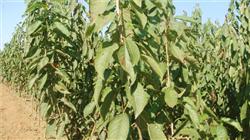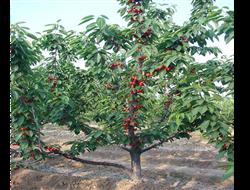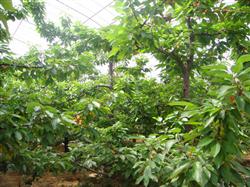How to graft sweet cherry in summer?

How to graft sweet cherry in summer? Please introduce the method of grafting sweet cherry in summer with reference to the following methods: the suitable time for bud grafting is early June (before the rainy season) and from late July to late August (from late rainy season to before cambium stops growing). In the rainy season (early July) bud grafting, the interface is easy to flow glue, wound healing is difficult, the survival rate is very low. First, T-shaped bud grafting. Take the full-growing new shoots, remove the leaves, use a grafting knife 2.5 cm below the grafting bud, horizontally cut to 1 cm of the xylem, then flatten it upward to 1 cm above the grafted bud, and then cut a knife horizontally 0.7 cm above the grafted bud, reaching to the xylem, you can remove the bud block which is similar to a rectangle. While cutting the bud block, cut the smooth part into a T-shaped interface with a knife at 5cm from the ground, reaching to the xylem, and its length is just enough to hold the bud block. Insert the cut bud block into the rootstock seedling interface to make the bud block closely coincide with the interface. Then use plastic strip to tie up all the incisions from top to bottom, exposing only axillary buds and petioles. Second, improve T-shaped bud grafting. The bud block has a small amount of xylem, and the grafting process is not the healing of the bud and the rootstock, but the healing of the edge of the bud and the cutting surface of the rootstock, so the bud grafting will not be damaged and the survival rate is higher. The cut bud should be large, generally at least 2.5 cm long and 1 cm wide, so that the contact surface is large and easy to survive. The plastic cloth should be removed in time about 10 days after budding, so as not to hinder the growth of callus and the development of budding. The petiole of the surviving bud is easy to fall off, and the interface heals well and the epidermis is fresh. For dead buds, if it is too late, they can be reconnected. Third, water management. If the weather persists before budding, the rootstock should be fully irrigated 2-3 days in advance, so as to make the grafting operation easier and improve the survival rate. However, do not irrigate within 15-20 days after grafting, and do a good job of drainage and waterlogging prevention if it rains during the period, so as to avoid glue flow and reduce the survival rate. Fourth, cut the anvil in spring. Budding seedlings are usually cut before sap flow in the early and middle March of the following year to facilitate bud grafting and growth. After cutting the rootstock, we should also pay attention to erase the sprouting rootstock buds at any time to prevent the consumption of too much nutrients and affect the growth of bud grafting. For the seedlings grafted in early June, the rootstock should be cut within 10 days after survival, so as to facilitate the germination and growth in the year of bud grafting. After survival, the bud grafted seedlings grow very rapidly, and the new shoots are brittle and tender, so it is necessary to add support in time to prevent them from being broken by the wind, which is also conducive to the vertical growth of seedlings. In order to promote the seedlings to grow sturdily, enrich and enhance their overwintering ability, the new shoots of the seedlings should be coring when the height of the seedlings is 40-50 cm. Click to get more cherry tree planting techniques click to get more fruit planting techniques
- Prev

What should you pay special attention to when planting sweet cherries in summer and autumn?
What should you pay special attention to when planting sweet cherries in summer and autumn? Please introduce that sweet cherry trees in summer and autumn are most afraid of stagnant water, such as yellow leaves, wilting, dead branches, poor tree growth, reduced yield, even dead trees, resulting in irregular sweet cherry orchards and low yield per unit area. After being waterlogged, it can aggravate the occurrence of glue disease. So, Sakura.
- Next

Greenhouse (greenhouse) how to manage cherries in summer?
Greenhouse (greenhouse) how to manage cherries in summer? Please introduce the management method in summer greenhouse (greenhouse) cherries can be managed with reference to the following methods: first, pay attention to summer shears in the removal of film at the same time to retract the crown, heavy strength pruning. 1. Return to the leadership of the Central Committee. This method can make each cherry.
Related
- Moge, come on! The staff of the peasant association in the producing area of cantaloupe were frightened when the crowd gathered.
- Causes and Solutions of low Fruit setting rate of Apple
- Symptoms and control measures of passion fruit virus disease
- Fruit growing lesson: how do apple orchards keep high yields?
- Can you build orchards in the mountains? What are the pros and cons?
- How to manage the coloring period of Crisson grape?
- This paper introduces the processing technology of two kinds of fig products.
- How much is a month for retired teachers in rural areas by 2020?
- How can strawberry planting increase sugar content? We should pay attention to management in many aspects.
- What are the cultivation techniques on how to improve the yield of golden fruit?

